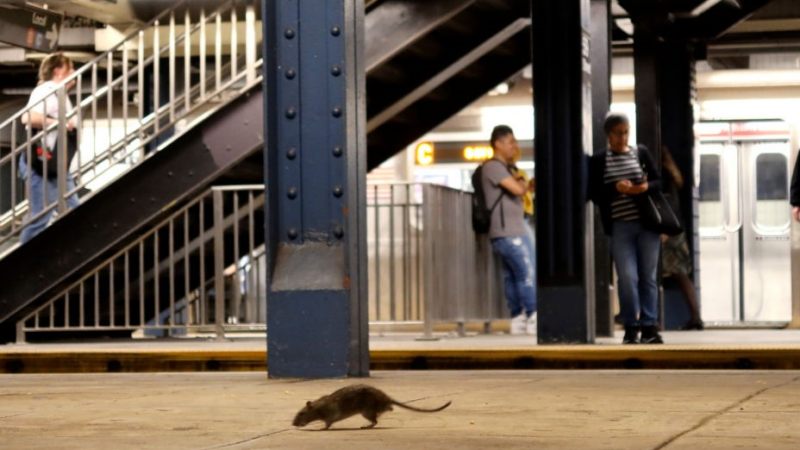A “golden age” of rat research may be here. What the often unwanted companions can teach us about us
When ecologist Jason Munshi-South started studying rodents in New York City, more than a decade ago, he was mainly interested in native animals— specifically white-footed mice. He’d visit the city’s parks and try to see how they were moving around and adapting to one of the most urbanized environments on Earth. But he found many New Yorkers he encountered during his fieldwork were more interested in hearing about another rodent.
“Everybody kept asking about rats,” he said.
So Munshi-South set out to answer what seemed like a pretty basic question: “What is a New York City rat? Where did they come from?”
The answer, he found, was complicated.
Rats are one of the most prolific mammals on the planet. Their close, often-fraught relationship with humans have allowed them to spread to pantries, sewers and garbage piles around the world. Domesticated brown rats are a commonly used mammal in laboratories making advancements in medicine and health.
But the history, evolution and ecology of rats – particularly the brown rat – isn’t well understood.
In a new paper published in the journal Science, Friday, Munshi-South and other researchers wrote that with advances in genomics and paleoarchaeology – the study of ancient humans – that’s about to change.
“I think we’re kind of at this cusp of a deluge of information about rats coming from these two fields,” he said.
Information could help scientists understand the first time humans and rats started commingling in East Asia, beginning – for the rats, at least – what would become one of the most successful partnerships in the world. Information could also further illuminate parts of human history like ancient trade corridors and human migrations. Rats have been traveling with and beside humans for thousands of years.
“What is so fun about brown rats and black rats is because they were moved by humans, they are this fun proxy to think about how humans connected as well,” said Emily Puckett, an associate professor at the University of Memphis, who did her postdoctoral research in Munshi-South’s lab and was not involved in the new paper. “If we’re connecting through trade and we’re also moving animals through trade, helping them do range expansion, then that’s saying something about us as well.”
The paper is one of three rat-focused reviews published in a special issue of Science aimed at better understanding what it calls, “our perennial rodent companions.”
The other reviews address emerging patterns in diseases that are able to jump from rodents to humans and a growing understanding, in the scientific community, of how intelligent and empathetic rats are. Studies have shown that rats in laboratory settings will help each other when they’re in distress, raising ethical concerns about their treatment in research.
“We have treated rats and the problems associated with them as a really simple issue. We see a rat, we don’t like it, we kill a rat,” said Kaylee Byers, an assistant professor at Simon Fraser University. “But rats and issues associated with them are incredibly complex.”
To manage them, she said, “We need to not only understand the rat, but we actually also have to understand ourselves and our relationship to rats in order to move towards a healthier coexistence.”
Transcript:
JUANA SUMMERS, HOST:
Now, here’s a truism you probably don’t need to be reminded of. Where there are humans, there are rats. The small, human-shadowing mammals can be found on every continent on earth. But there’s a lot people still don’t know about their history. And as NPR’s Nathan Rott reports, that may soon change.
NATHAN ROTT, BYLINE: About a minute into talking with Jason Munshi-South, I mentioned that I recently moved into a new house in Southern California, and he immediately assumed that I was about to bring up a rat problem.
Not yet.
JASON MUNSHI-SOUTH: My brother lives in Pasadena, and when I was there, there were rats running around on the roof of his garage. And he was like, can you get rid of these (laughter)? Like, I’ll try.
ROTT: Munshi-South is an ecologist, a scientist at Drexel University, not a pest control expert. But, he says…
MUNSHI-SOUTH: Once you start working on rats, people have a lot of practical questions they want to ask you.
ROTT: Humans and rats have had a – let’s call it volatile – relationship for thousands of years. That’s because rats are what scientists call a commensal species.
MUNSHI-SOUTH: And in Latin, that literally means eating from the same table, so…
ROTT: You’d hope they’re not eating literally from the same table.
MUNSHI-SOUTH: (Laughter) Sometimes they are, but – I’ve had some stories. There are infamous videos of this. But rats are companions almost. They’re pests, but they’re also companions.
ROTT: In a new paper in the journal Science, which has dedicated a special section to the furry, often unwanted companions, Munshi-South says that despite that long relationship, there’s still a lot that people don’t know about how rats came to be so close and so ubiquitous across the world.
MUNSHI-SOUTH: This is just a really complicated, tangled story that nobody has adequately addressed.
ROTT: Which may seem weird because rats have been used as pets and food throughout human history, and they also carry diseases and are critical to laboratory research on medicine and health, two other topics highlighted in the journal. Munshi-South says thanks to advances in genetics and paleoarchaeology, the study of ancient humans, scientists are about to learn a lot more about the creatures.
MUNSHI-SOUTH: We’re at this cusp of a deluge of information about rats coming from these two fields.
ROTT: Which is important why?
MUNSHI-SOUTH: It’s an interesting historical question in its own right because it actually maps on with human economies, human migrations, trade corridors, all these other things. They actually help us understand, as kind of a proxy, what humans were doing in various places and at various times.
ROTT: Learning about rats helps us learn about us, which is something that Kaylee Byers, an assistant professor at Simon Fraser University in Canada, thinks is true even in the modern sense.
KAYLEE BYERS: We need to not only understand the rat, but we actually also have to understand ourselves and our relationship to rats in order to move toward sort of like a healthier coexistence and management of these animals.
ROTT: Because love them, hate them, scared of them – rats are here to stay. Nathan Rott, NPR News.
Election officials on edge as voting begins. And, Haitians suffer from Trump’s claims
General election voting for 2024 is commencing as election officials worry about the threat level they face. And, the Haitian community is suffering from Trump's false claims that they eat pets.
2 former migrant farmworkers reflect on their journey together
Emma and Rogelio Torres reminisce about how unlikely a pairing they were when they first met as migrant farmworkers in Arizona. They met in the 80s near Yuma — with love the last thing on their minds.
Deadly high blood pressure during pregnancy is on the rise
More pregnant women are being diagnosed with dangerously high blood pressure, which risks the life of the parent and child. Montana is one of the states improving screening and treatment.
Voters are advised to return their ballots early because of mail delay concerns
Election officials are raising concerns about the U.S. Postal Service's ability to handle this fall’s expected influx of election mail. But USPS say it’s ready to deliver the country’s ballots.
Turkey wants to regulate Germany’s beloved döner kebab street food
Under Turkey's proposal, beef would be required to come from cattle that is at least 16 months old, and be marinated with specific amounts of fat, yogurt or milk, onion, salt, thyme, and pepper.
An iconic Churchill photo stolen in Canada and found in Italy is ready to return
Canadian and Italian dignitaries marked the successful recovery of a portrait of Winston Churchill known as "The Roaring Lion," stolen in Canada and recovered in Italy after a two-year search.




